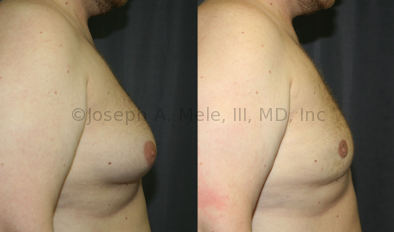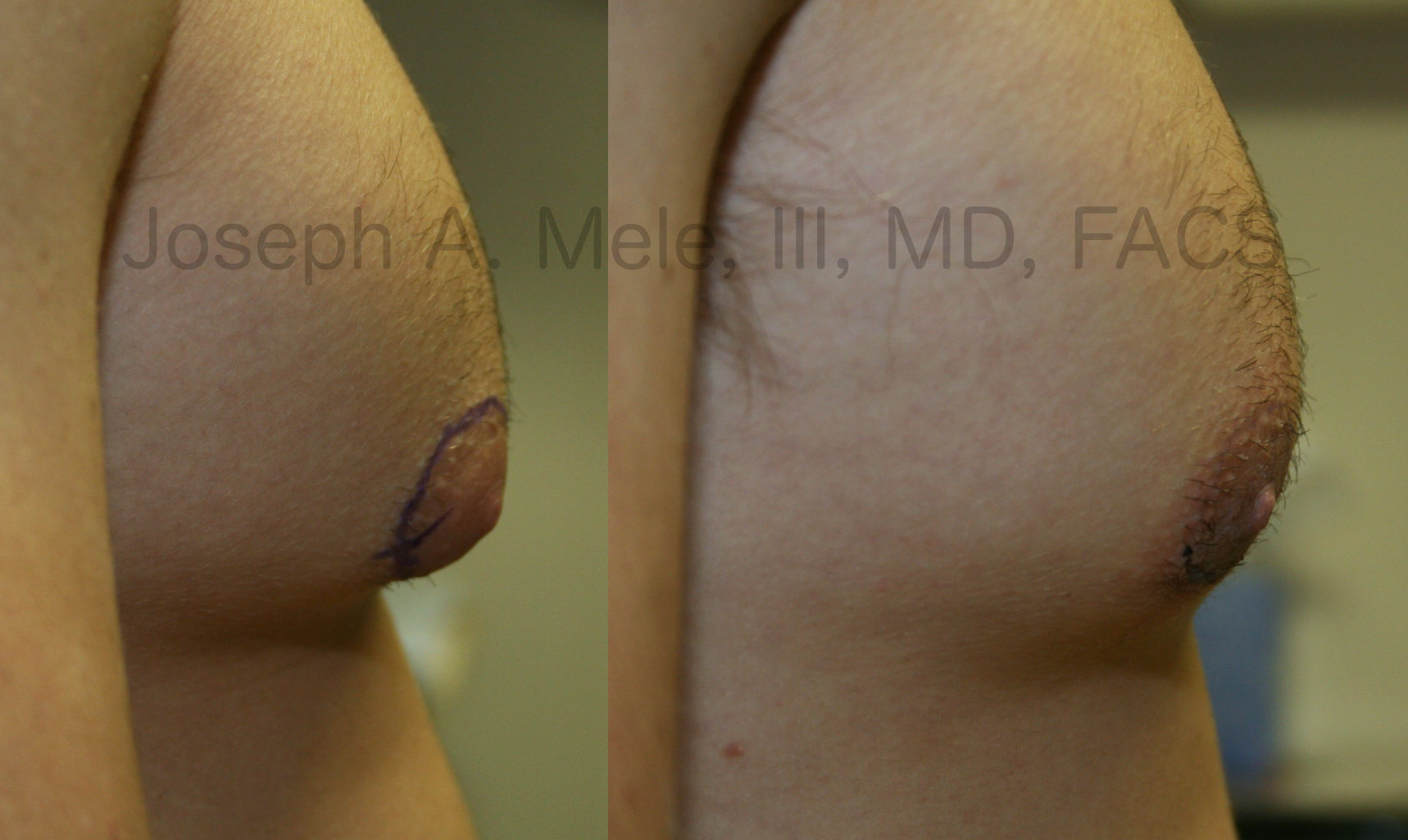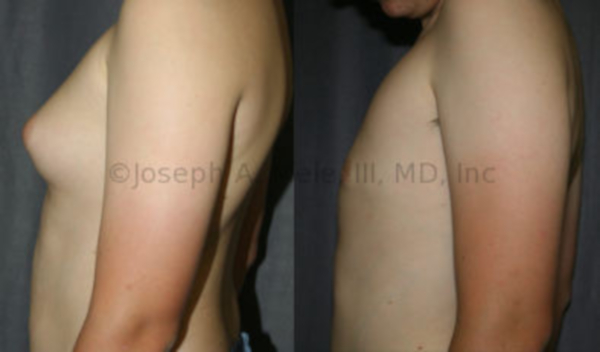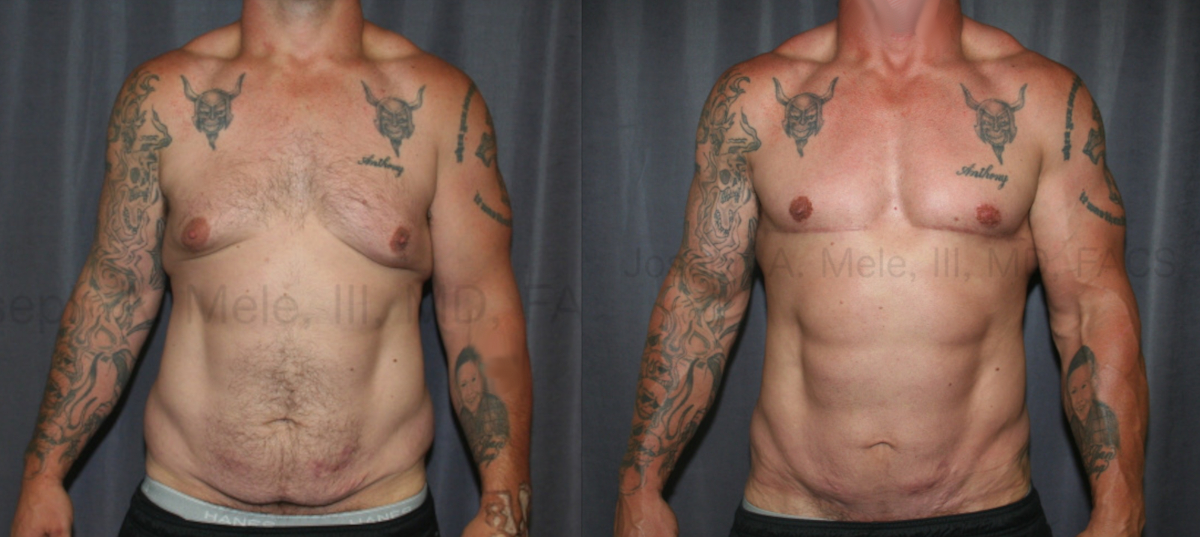Gynecomastia is the medical term for the enlargement of male breast tissue. It is a common condition that affects millions of men worldwide, regardless of age or body type. The enlargement can be caused by hormonal imbalance, certain medications, genetics, or other medical factors. While not typically dangerous, gynecomastia often causes significant emotional distress, embarrassment, and self-consciousness.
Male Breast Reduction Surgery, or Gynecomastia Correction, is a procedure designed to flatten and firm the chest by removing excess glandular tissue, fat, and sometimes skin. Regardless of the technique, the goal is to create a more masculine, contoured chest that looks natural both in and out of clothing. Today’s post reviews the most common procedures, and why they are selected, but first let’s review the causes of Gynecomastia.
Causes of Gynecomastia
Gynecomastia can develop at any stage of life, but most commonly it occurs with puberty. A few of the most common causes include:
- Hormonal Imbalance: When the ratio of estrogen to testosterone shifts, breast tissue may grow. This can occur naturally during puberty, aging, or due to endocrine disorders.
- Medications: Drugs for conditions like prostate cancer, hypertension, heart disease, or depression can cause breast tissue growth as a side effect.
- Substance Use: Anabolic steroids, alcohol, marijuana, and certain recreational drugs have been linked to gynecomastia.
- Health Conditions: Liver disease, kidney failure, thyroid disorders, and testicular tumors can all disrupt hormone levels.
- Genetics or Idiopathic Causes: In many men, no specific cause is identified.
In true Gynecomastia, the excess is though glandular tissue, not just fat. Some men, however, have Pseudogynecomastia, in which excess fat (rather than glandular tissue) creates the enlarged chest appearance. Which type of gynecomastia a patient has is determined during an in person consultation appointment with a Board Certified Plastic Surgeon. This is an essential step in planning effective treatment.
Candidacy for Male Breast Reduction
Men who are good candidates for gynecomastia surgery typically:
- Have excess breast tissue or localized fat resistant to diet and exercise
- Are in good general health and maintain a stable weight
- Have firm, elastic skin for optimal contouring
- Are non-smokers (or willing to quit before and after surgery)
- Have realistic expectations about the outcome
Surgery is not recommended for men with untreated hormonal or medical conditions that may continue to stimulate breast growth. In those cases, addressing the underlying issue is a priority before surgical intervention.
Preoperative Evaluation
A thorough consultation includes a detailed medical history and physical examination. The Plastic Surgeon will assess:
- The proportion of glandular versus fatty tissue
- The amount of excess skin
- The symmetry of the chest
- Skin tone and elasticity
Photographs are taken for planning and comparison, and we discuss which surgical techniques are best suited for the patient’s anatomy.
Gynecomastia Removal Techniques
There are several approaches to Male Breast Reduction, and the optimal technique depends on the type and severity of Gynecomastia. The main methods include liposuction, excision, and a combination of both.
1. Liposuction Techniques
Liposuction is ideal for patients whose gynecomastia is primarily caused by excess fat with minimal glandular tissue and good skin elasticity.
Procedure Steps:
- Anesthesia: Usually general anesthesia is used for Gynecomastia Reduction, though for small areas of hypertrophy, local anesthesia with sedation may be an option.
- Incisions: Small incisions (5 mm) are made in the axilla (arm pits), near the edge of the areola or along the natural chest crease.
- Fat Removal: A cannula (thin metal tube) is inserted to loosen and suction out excess fat using various methods such as tumescent suction-assisted liposuction (SAL), ultrasound-assisted (UAL), or power-assisted (PAL) liposuction.
- Contouring: The surgeon carefully sculpts the chest to achieve smooth, even contours and natural masculine definition.

Pseudogynecomastia is disproportionate fat of the chest. Since fat is softer than true gynecomastia, it can often be treated with liposuction alone. With firm skin tone, results are more predictable.
Advantages of Liposuction for Gynecomastia:
- Minimal scarring
- Short recovery time
- Suitable for mild to moderate cases of Pseudogynecomastia

Large pseudogynecomastia reduction is less predictable. Liposuction can remove the fat; however, when the breasts grow, the skin grows too. Without excision of excess skin, fullness can remain.
Limitations of Liposuction for Gynecomastia:
- Ineffective for dense glandular tissue, even small amounts. Excision is more effective.
- May not address significant skin excess, especially with poor skin tone and after weight loss
2. Excision (Glandular Tissue Removal)

Localized gynecomastia can cause puffy nipples. Smaller cases are treated with direct excision of the gland via an incision placed along the areola.
When glandular tissue or excess skin is present, direct excision is necessary.
Procedure Steps:
- Incision: Typically placed along the lower half of the areola (periareolar incision) for discreet scarring.
- Tissue Removal: The surgeon removes firm glandular tissue directly beneath the nipple and surrounding area.
- Skin Tightening (if needed): In cases of minimal sagging, excess skin is trimmed and the nipple-areola complex may be repositioned. Significant sagging may require nipple repositioning and skin excision as shown below.
- Closure: The incisions are closed with fine sutures, often dissolvable, and small drains may be used temporarily to prevent fluid buildup.
Advantages:
- Precise removal of glandular tissue
- Allows correction of severe or long-standing gynecomastia
- Can address minimally stretched skin and nipple position
Limitations:
- More invasive than liposuction alone
- Slightly longer recovery period
3. Combined Approach

True Gynecomastia is the development of firm glandular tissue. A combination of liposuction and direct excision is needed to remove the tough gland and provide a flattened, masculine chest.
The majority of Gynecomastia Surgeries use a combination of liposuction and excision. Liposuction contours the chest and removes excess fat, while excision ensures complete removal of dense glandular tissue that liposuction cannot eliminate.
This hybrid approach offers the most comprehensive correction and natural results for my patients and is a procedure I perform weekly.
4. Gynecomastia Reduction with Skin Reduction
After massive weight loss, loose skin complicates Gynecomastia Reduction. Reduction of the subcutaneous tissue allows the skin to collapse and sag. In the case below, the excess skin and sagging nipples needed to be addressed for optimal results.

Male Breast Reduction and Tummy Tuck before and after pictures. A combined approach to gynecomastia, excision of the excess chest skin and a Mini Tummy Tuck were used to masculinize the chest and abdomen.
In the above case multiple techniques were needed:
- Liposuction: to contour the chest and breasts
- Nipple Repositioning: the nipples were moved up on the chest wall. In this case as skin grafts.
- Areola Reduction: the pigmented skin around the nipples was reduced and made more symmetrical.
- Skin Removal: Excess skin was removed via an incision placed beneath the breasts, in the inframammary fold, to hide it.
- Mini Tummy Tuck: Skin was removed from the lower abdominal wall to tighten the abdominal wall, too.
Recovery and Results
Immediate Postoperative Period:
- Compression garments are worn continuously for several weeks to minimize swelling and help the skin conform to the new chest shape.
- Temporary bruising, swelling, and mild discomfort are common. Pain is usually well managed with oral medication.
- Most patients return to light activities in 3–5 days and can resume exercise within 3–4 weeks.
Healing Timeline:
- Swelling subsides gradually over 4–6 weeks.
- Final results are visible within 3–6 months as tissues settle and scars mature.
- Scars fade over time and are usually concealed in natural contours.
Results:
The outcome is a flatter, firmer, and more masculine chest. Most men report a significant improvement in self-esteem, posture, and confidence—particularly when wearing fitted clothing or going shirtless.
Risks and Complications
While male breast reduction is a safe and highly effective procedure, potential risks include:
- Infection or bleeding
- Asymmetry or contour irregularities
- Visible scarring
- Temporary loss of nipple sensation
- Fluid accumulation (seroma)
- Overcorrection or undercorrection
Choosing a Board Certified Plastic Surgeon with experience in gynecomastia correction minimizes these risks and ensures the most natural results.
Alternative and Non-Surgical Treatments
Non-surgical methods may be considered in select cases:
- Weight Loss: Beneficial for pseudogynecomastia (fat-related enlargement).
- Hormonal Therapy: For cases linked to endocrine imbalance.
- Medication Adjustment: If caused by a drug side effect, alternative medications may be explored.
However, true glandular gynecomastia does not resolve without surgery once established.
Conclusion
Male Breast Reduction is one of the most satisfying and transformative cosmetic procedures for men. By removing excess fat, glandular tissue, and skin, it restores a natural, masculine chest contour and improves self-confidence.
Advancements in Liposuction and surgical techniques have made the procedure safer, more precise, and less invasive. Whether performed for cosmetic or psychological reasons, Gynecomastia Surgery offers lasting physical and emotional benefits, helping men feel more comfortable in their appearance and confident in their everyday lives.
In the San Francisco Bay Area call (925) 943-6353 o schedule your private consultation appointment.
Previous Post Next Post